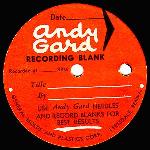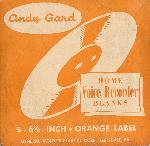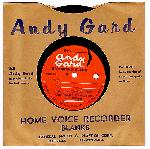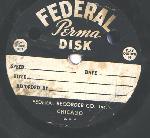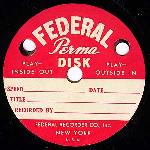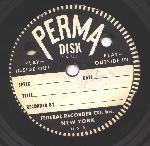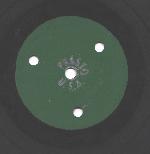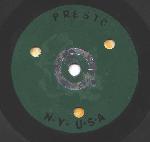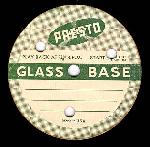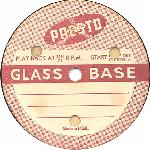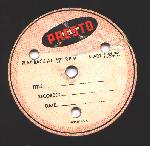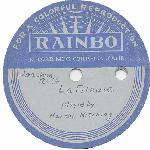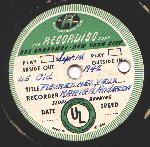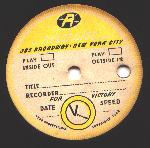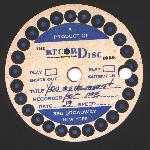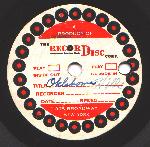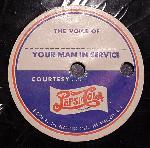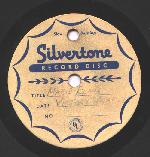Note: This page hasn't been updated in some time, but I am still collecting images and information.
The principal goal of this project is to assemble an illustrated list of label types found on home recording discs of the mid-twentieth century. A further and perhaps more important goal is to produce a dating guide for home recording discs. Obviously there is no way to determine the date of an undated home recording with certainty based only on the label type. People often used blank discs many years after they were originally produced; I have discs in my collection manufactured during World War Two but recorded in the 1960s, and some people are still making recordings on vintage blanks. However, by determining approximately when each label type was originally introduced, we can at least come up with a set of earliest possible recording dates for disc home recordings. For example, a disc with a label type introduced about 1945 cannot have been recorded earlier than that, although it could have been recorded much later. Furthermore, it is likely that a majority of discs were in fact recorded a short time after their initial sale, so we might eventually be able to hazard educated guesses of, say, "circa 1946-47" based on a given label type. |
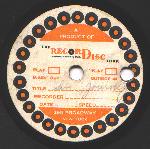
When was this recording made? Guesses, anyone?
|
But how can we figure out when each label type was introduced? That's where you can help if you have any home disc recordings in your possession. Often discs have handwritten dates indicating when they were recorded. Sometimes people mention the year during the course of a recording (especially common in New Year's Eve recordings). Other times the content of a recording will indicate a year or historical period, such as the Second World War. If enough people check the dates on their records against the list on this website and report the results, I will be able to find out:
 |
- the earliest date found on each label type, which must be roughly when the label type was introduced. Undated discs are then very unlikely to have been recorded before this date.
- the range of dates that turn up on each label type, which will help establish the statistical likelihood that an undated recording falls within a certain time period
|
In this way we can establish a sound basis for making educated guesses about the dates of undated home recordings. There are obviously no discographies or recording ledgers, so this is probably the best we can do!
Scans of label types not found here are also eagerly sought.
All those interested in any aspect of this project, please contact me at pfeaster@gmail.com.
Special thanks to Eric Morritt, Graham Newton, and Bob Thorne.
Audiodisc
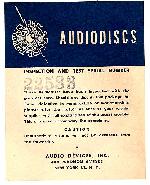
|
From Eric Morritt: All audiodiscs had their logo and a batch code number (that's the "A###" number) stamped around the center hole, whether they were for home or professional use. Those sold with a label for home use simply didn't show the batch code information as it was obviously under the label. Audio Devices, Inc. (the manufacturer of Audiodiscs until Capitol took over the operation, I believe in the late 1960's or early 1970's) used this number to refer back to manufacturing batches of disc substrates, acetate coatings, etc., so if there was a problem with a batch they could go back and find out exactly what conditions, materials, etc. the disc was made under/with and try to correct whatever problem had come up. I have also attached ... a scan of the warranty slip that was included in boxes of discs for home use.
|
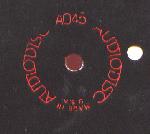 |
Audiodisc "A045" -- 12" aluminum core.
Example of disc without label showing batch code number. This one was recorded in April 1961. |
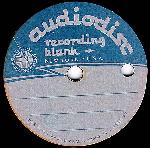 |
Audiodisc, Type 1. -- blue and white variety.
Picture supplied by Eric Morritt. |
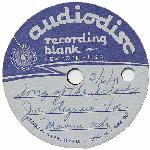 |
Another example of Audiodisc Type 1, picture supplied by Bob Thorne, dated March 1941. |
 |
Audiodisc, Type 2. -- black and light yellow variety.
Picture supplied by Eric Morritt. |
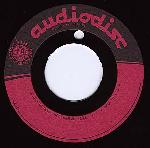 |
Audiodisc with 45 rpm spindle hole
Picture supplied by Eric Morritt. |
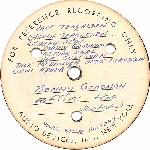 |
For reference recording only / Audio Devices, Inc.
Picture supplied by Bob Thorne. |
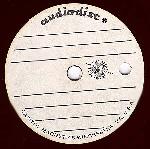 |
Audiodisc, Type 3. -- "Capitol Magnetics, Winchester VA."
Picture supplied by Eric Morritt, who received it from Capitol sometime during the 1970s. Not known whether it was for home recorders or mastering in professional labs. |
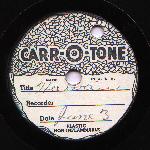 |
Carr-O-Tone.
6 1/2-inch fibre core disc.
Caution: the surface of these discs is unstable and sticky!
Dates attested: February 1942. |
Duodisc
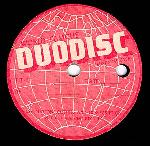 |
Duodisc Type 1.
Picture supplied by Eric Morritt. |
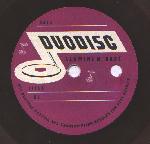 |
Duodisc Type 2 -- purple.
Dates attested: 1948.
|
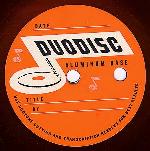 |
Duodisc Type 2 -- red.
Picture supplied by Eric Morritt. |
Federal Perma-Disc
Howard
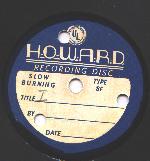 |
Howard Type 1. Fibre-core disc. "Type 8F" may refer to the fact that this is an eight inch diameter fibre-core disc.
Dates attested: none explicit, but one recorded during WWII. |
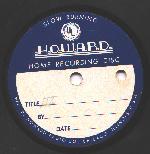 |
Howard Type 2. Fibre-core disc.
Dates attested: December 1946; another found recorded during WWII. |
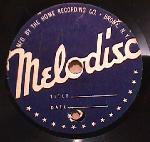 |
Melodisc. "Mfd. by the Home Recording Co., Bronx, N. Y."
Picture supplied by Graham Newton.
|
National Hollywood
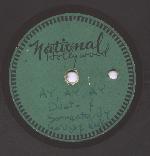 |
National Hollywood Type 1. Fibre-core disc.
Dates attested: 1943. |
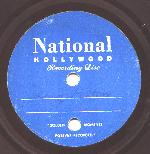 |
National Hollywood Type 2. Aluminum-core disc with red lacquer.
Dates attested: 1961. |
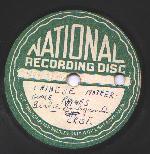 |
National Recording Disc. Aluminum-core disc.
Not certain whether any connection with the "National Hollywood" label.. |
Philco
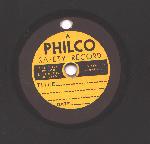 |
Philco Type 1. Fibre-core discs (6 1/2" attested)
Dates attested: December 1940. |
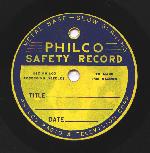 |
Philco Type 2. Steel-core discs.
Dates attested: December 1940, June 1941. |
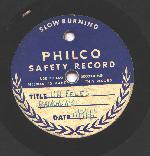 |
Philco Type 3. Fibre-core discs (8" attested).
Dates attested: October/November 1941. |
Presto
RCA Victor
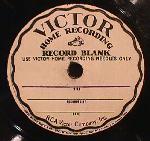 |
Victor Home Recording Record Blank.
Pre-grooved 6" disc.
Picture supplied by Graham Newton. |
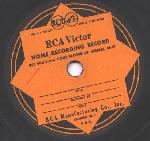 |
Victor Home Recording Record.
Pre-grooved 10" disc. H-103 in wax. "RCA Victor" at top of label.
Dates attested: 1933, 1934, 1935, 1936, 1937.
|
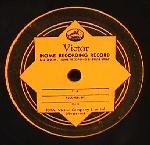 |
Victor Home Recording Record, Canadian Variant.
10" disc. "Victor" at top of label.
Picture supplied by Graham Newton. |
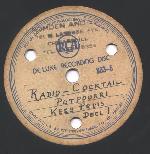 |
RCA De Luxe Recording Disc 803-5
10" aluminum core disc. |
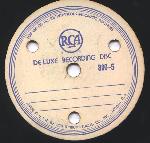 |
RCA De Luxe Recording Disc 806-5
12" aluminum core disc.
Dates attested: December 1939, December 1941. |
Recordisc
Silvertone
Soundcraft
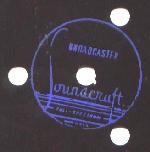 |
Soundcraft "Broadcaster" -- embossed
Dates attested: 1948. |
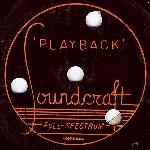 |
Soundcraft "Playback" -- embossed
Picture supplied by Eric Morritt. |
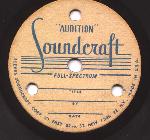 |
Soundcraft "Audition" Type 1.
10" disc recorded at 78 rpm. |
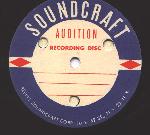 |
Soundcraft "Audition" Type 2.
12" disc recorded at 33 1/3 rpm. |
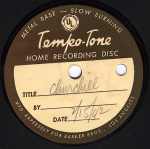 |
Tempo-Tone. Manufactured for Barker Brothers, Los Angeles. Dated 1942.
Picture supplied by Eric Morritt.
|
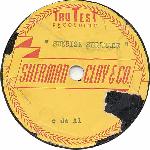 |
Tru-Test Recording / Sherman Clay & Co.
Picture supplied by Bob Thorne. |
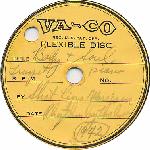 |
Va-Co Flexible Disc.
Example shown is dated 1942.
Picture supplied by Bob Thorne. |
Wilcox-Gay Recordio
Click on image below for larger version. |
Wilcox-Gay Recordio Type 1. This appears to have been the first label design, since it is only found on fibre core discs. There are at least two color schemes, one (1A, 1B) red, white, and black with a yellow recording area; the other (1C) gray and black with a black recording area. Not sure yet whether the color schemes were coded to different sized discs or whether these belong to two sequential periods. |
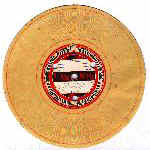 |
Wilcox-Gay Recordio Type 1A
6 1/2" fibre core disc. Notable for having three additional holes for securing the disc during recording instead of one. "Slow burning material."
Dates attested: January 1944. |
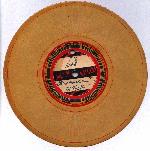 |
Wilcox-Gay Recordio Type 1B
6 1/2" fibre core disc. No "slow burning" indication.
Dates attested: February 1944. |
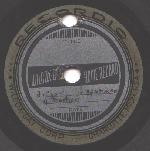 |
Wilcox-Gay Recordio Type 1C
10" fibre core disc. No "slow burning" indication.
Markings are identical to 1B, but the color scheme is different. |
|
Wilcox-Gay Recordio Type 2. These labels were probably introduced when Wilcox-Gay began marketing metal-core discs that needed separate labels glued onto the disc surface rather than printed-on labels as before. Apparently for consistency they also produced some fibre-core discs with the new glued-on labels (which don't have outer rings because they never went through a printing stage). Only one color scheme is known: brown and white. |
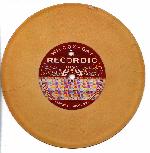 |
Wilcox-Gay Recordio Type 2 on fibre core disc
6 1/2" fibre core disc. No "slow burning" indication.
Dates attested: December 1944. |
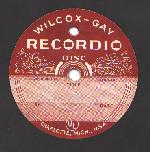 |
Wilcox-Gay Recordio Type 2 on metal core disc
Metal core disc. Identified as "Slow burning red label."
Dates attested: June 1950 [presumably much earlier though] |
|
Wilcox-Gay Recordio Type 3. When Wilcox-Gay resumed printing labels directly on fibre-core discs, they introduced a new label design, the familiar "triangle" found throughout the late 1940s. |
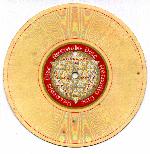 |
Wilcox-Gay Recordio Type 3A variant 1. Fibre core discs kept the same layout and color scheme until the switch to label type 5. However, there are at least two detectable variants. Variant 1, which appears to be older, uses a darker color of gold for the triangle detail and the same sans-serif font as the metal core discs.

Dates attested: January 1947.
|
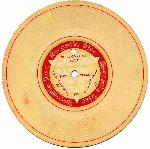 |
Wilcox-Gay Recordio Type 3A variant 2. Fibre core disc. This has a much lighter color of gold for the triangle detail and uses a slightly larger serif font.

|
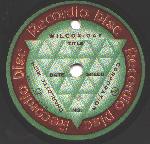 |
Wilcox-Gay Recordio Type 3B.
Metal core disc.
Label in green, brown, and white. |
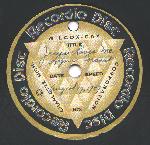 |
Wilcox-Gay Recordio Type 3C.
Metal core disc. Unusual for having no "slow burning" indication.
Label in gold, black, and white.
Dates attested: March 1947, August 1947.
|
|
Wilcox-Gay Recordio Type 4. Found only on metal-core discs, this type has "Recordio Disc" in all capitals. |
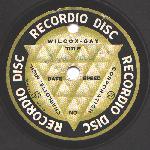 |
Wilcox-Gay Recordio Type 4A, black lacquer.
Label in gold, black, and white.
Metal-core disc with black lacquer. |
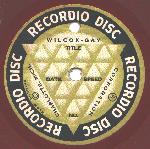 |
Wilcox-Gay Recordio Type 4A, red lacquer.
Label in gold, black, and white.
Metal-core disc with red lacquer. |
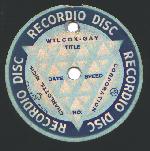 |
Wilcox-Gay Recordio Type 4B.
Label in blue and white.
Metal-core disc with black lacquer.
Dates attested: December 1947, August 1948. |
|
Wilcox-Gay Recordio Type 5. This variety has a copyright date of 1950 and seems to be the latest label variety. |
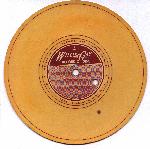 |
Wilcox-Gay Recordio Type 5A. On yellow fibre-core discs this label was printed on in brown ink. |
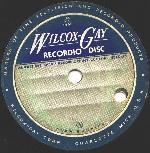 |
Wilcox-Gay Recordio Type 5B, black lacquer. On metal-core discs the label is blue on white with light gold details.
Dates attested: April 1951. |
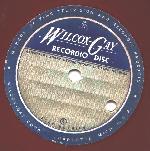 |
Wilcox-Gay Recordio Type 5B, red lacquer. The label is otherwise identical to the above. |
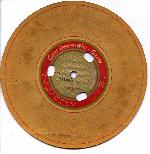 |
Wilcox-Gay Coin-Recordio-Gram.
6 1/2 inch single-sided fibre core disc. Has a copyright date of 1948. But there were Recordio-Grams before this, so there are presumably other variants on this label. |
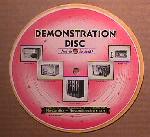 |
Wilcox-Gay Demonstration Disc.
"Not to be sold."
Picture supplied by Graham Newton. |
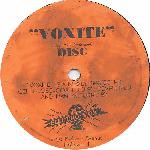 |
Voxite Disc: "'Voxite' is a newly perfected cellulose-coated disc developed and perfected by Electro-Vox , 5546 Melrose Avenue, Hollywood."
Picture supplied by Bob Thorne. |
 |
Zenith Universal Recorder.
Does anyone have an example of a machine by this name?
Picture supplied by Eric Morritt. |
|
|




